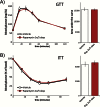Intermittent Administration of Rapamycin Extends the Life Span of Female C57BL/6J Mice
- PMID: 27091134
- PMCID: PMC4906329
- DOI: 10.1093/gerona/glw064
Intermittent Administration of Rapamycin Extends the Life Span of Female C57BL/6J Mice
Abstract
Inhibition of the mTOR (mechanistic target of rapamycin) signaling pathway by the FDA-approved drug rapamycin promotes life span in numerous model organisms and delays age-related disease in mice. However, the utilization of rapamycin as a therapy for age-related diseases will likely prove challenging due to the serious metabolic and immunological side effects of rapamycin in humans. We recently identified an intermittent rapamycin treatment regimen-2mg/kg administered every 5 days-with a reduced impact on glucose homeostasis and the immune system as compared with chronic treatment; however, the ability of this regimen to extend life span has not been determined. Here, we report for the first time that an intermittent rapamycin treatment regimen starting as late as 20 months of age can extend the life span of female C57BL/6J mice. Our work demonstrates that the anti-aging potential of rapamycin is separable from many of its negative side effects and suggests that carefully designed dosing regimens may permit the safer use of rapamycin and its analogs for the treatment of age-related diseases in humans.
Keywords: Anti-aging; Life span; Mice; Rapamycin; mTOR.
© The Author 2016. Published by Oxford University Press on behalf of The Gerontological Society of America. All rights reserved. For permissions, please e-mail: journals.permissions@oup.com.
Figures




References
MeSH terms
Substances
Grants and funding
LinkOut - more resources
Full Text Sources
Other Literature Sources
Medical
Miscellaneous

